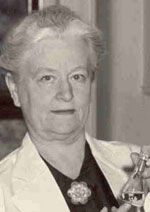RCSA’s Catalytic Funding Builds Science Careers
In 1977 Research Corporation for Science Advancement provided $200,000 to Mount Holyoke College in South Hadley, MA, to endow the Rachel Brown Scholarship as a catalyst for improving America's scientific workforce. Early this year, the college announced the latest two recipients of that scholarship, Xiaowen Wang, a senior chemistry and biology major from China, and Yemsratch Akalu, a junior biochemistry major from Ethiopia. Wang is currently undertaking a senior thesis project in biochemistry, studying the fine structure of E. coli RNA polymerase and how it binds to DNA during the transcription process. Her other research interests include stem cell biology and regenerative medicine. Akalu has been conducting independent research in immunology, most recently looking at how signaling carried out through cytotoxic T-lympocyte antigen 4 (CTLA-4) affects the early development of Murine-AIDS. Last year, she conducted laboratory research related to gene therapy for cystic fibrosis. "The Rachel Brown Scholarship is a small but important example of how RCSA and other independent foundations are catalysts for the betterment of science and our scientific workforce," says RCSA President and CEO James M. Gentile. "It is vitally important that more women be encouraged to take up scientific careers." Mount Holyoke is one of the nation's premier research and liberal arts colleges for women. Brown was a 1920 graduate of Mount Holyoke. Along with her research partner at the New York State Department of Health, Elizabeth Hazen, she developed the antifungal drug nystatin in 1950. RCSA helped Brown and Hazen patent and license their discovery as Mycostatin, which was subsequently distributed by the E.R. Squibb pharmaceutical company.
The two researchers used their profits to establish the Brown-Hazen Research Fund for scholarships and research at American colleges and universities; the fund was administered by RCSA.
Royalties from these activities were powerfully catalytic. RCSA records indicate that between 1956 and 1978, when the Mycostatin patents expired, the Foundation had paid out $6.5 million via the Brown-Hazen Fund. For their work, Brown and Hazen received the Chemical Pioneer Award from the American Institute of Chemists in 1975, the first women to receive that honor. Brown died in 1980.
The scholarship in her name at Mount Holyoke goes to students with strong academic records who are majoring in biological or physical sciences.
"We usually choose two students per year to receive a portion of their financial aid from this fund," says M. J. Maccardini, associate director of corporate and foundation relations. "For this scholarship, we choose students who are strong scientists, who embody what Rachel Brown was interested in, and are the type of student she would have been proud to support."
When the young Rachel Brown came to study at Mount Holyoke, she intended to major in history, according to college sources. But she took a chemistry course and found that she enjoyed chemical analysis; ultimately she did a double major in history and chemistry. Brown went on to get her Ph.D. at the University of Chicago.
Today the Rachel Brown Scholarship endowment has a market value of approximately $1.4 million and pays out roughly $60,000 annually. Maccardini says it is used to cover the bulk of annual expenses for the most talented and neediest students.
"A catalyst is a substance that initiates or accelerates a chemical reaction without itself being affected," Gentile notes. "Over 30 years, at two students per year, this single scholarship, one of many generated by the Brown-Hazen Research Fund, has had an incredibly powerful catalytic effect - and it's encouraging to see that Mount Holyoke has managed to make the funds grow."
Brown was a 1920 graduate of Mount Holyoke. Along with her research partner at the New York State Department of Health, Elizabeth Hazen, she developed the antifungal drug nystatin in 1950. RCSA helped Brown and Hazen patent and license their discovery as Mycostatin, which was subsequently distributed by the E.R. Squibb pharmaceutical company.
The two researchers used their profits to establish the Brown-Hazen Research Fund for scholarships and research at American colleges and universities; the fund was administered by RCSA.
Royalties from these activities were powerfully catalytic. RCSA records indicate that between 1956 and 1978, when the Mycostatin patents expired, the Foundation had paid out $6.5 million via the Brown-Hazen Fund. For their work, Brown and Hazen received the Chemical Pioneer Award from the American Institute of Chemists in 1975, the first women to receive that honor. Brown died in 1980.
The scholarship in her name at Mount Holyoke goes to students with strong academic records who are majoring in biological or physical sciences.
"We usually choose two students per year to receive a portion of their financial aid from this fund," says M. J. Maccardini, associate director of corporate and foundation relations. "For this scholarship, we choose students who are strong scientists, who embody what Rachel Brown was interested in, and are the type of student she would have been proud to support."
When the young Rachel Brown came to study at Mount Holyoke, she intended to major in history, according to college sources. But she took a chemistry course and found that she enjoyed chemical analysis; ultimately she did a double major in history and chemistry. Brown went on to get her Ph.D. at the University of Chicago.
Today the Rachel Brown Scholarship endowment has a market value of approximately $1.4 million and pays out roughly $60,000 annually. Maccardini says it is used to cover the bulk of annual expenses for the most talented and neediest students.
"A catalyst is a substance that initiates or accelerates a chemical reaction without itself being affected," Gentile notes. "Over 30 years, at two students per year, this single scholarship, one of many generated by the Brown-Hazen Research Fund, has had an incredibly powerful catalytic effect - and it's encouraging to see that Mount Holyoke has managed to make the funds grow."






